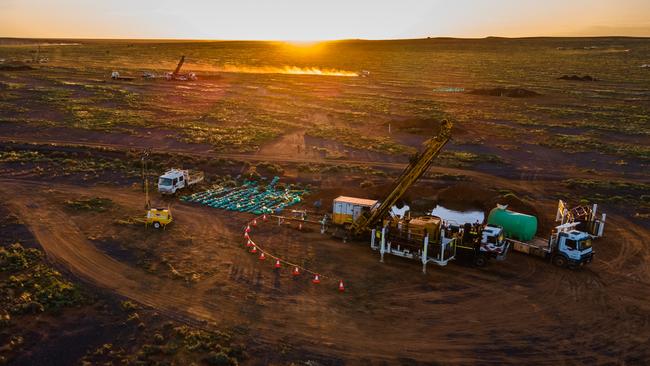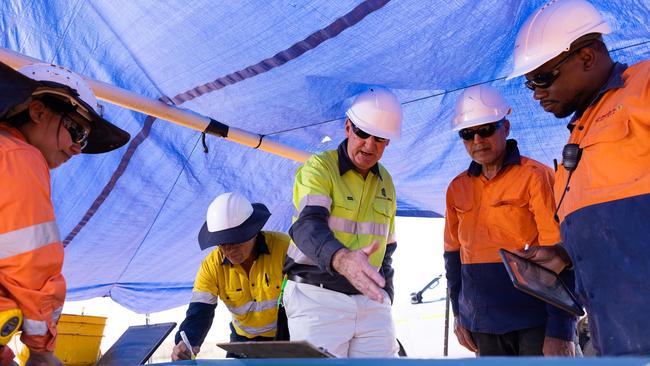Hawsons Iron confident of new iron ore front near Broken Hill
Iron ore hopefuls have been kicking the rocks along the Braemar Formation, stretching from South Australia up toward Broken Hill, without luck for decades.

Iron ore hopefuls have been kicking the rocks along the Braemar Formation, stretching from South Australia up toward Broken Hill, without luck for decades.
Hawsons Iron is the latest – but it says the run of bad luck is about to change. It hopes to complete a feasibility study this year.
And it believes the change in the wind on environmental and sustainability concerns will drive demand for its soft magnetite product, and spur investor interest in the company itself, which intends to extract the mineral with a minimum of energy expended.
The company, formerly known as Carpentaria Resources, had put out a pre-feasibility study on the Hawsons project in 2017, but board ructions and the divided ownership of the asset were a distraction from the main game.
With Hawsons Iron now owning 93.9 per cent of the asset after a deal finalised in May last year, and stability among the board and executive, the company is now forging ahead, executive chairman Bryan Granzien says.
And the progress is being reflected in the share price, which is up from 3c a year ago to a close of 19c on Friday, valuing the company at $136m.
The Hawsons pre-feasibility study envisaged an export operation of 10 million tonnes year, with the product to be shipped via slurry pipeline to Broken Hill, where it would be sent for export probably through Port Pirie.
It would have cost $US1.4bn ($1.97bn) to develop, and generated on average $US881m a year, based on an iron ore price around $US75 a tonne.

The company says it will test a larger, 10-20mtpa operation as part of the BFS, and all options for logistics, such as the use of other ports, will be considered, given the considerable amount of time that has passed since the initial study.
“This is crucial, given current market conditions are very different to 2017 with the emergence of new technologies, ESG considerations and decarbonisation strategies since the PFS was completed,’’ the company said.
Mr Granzien said the company’s timing in coming to the market as investor concerns around ESG issues – including carbon dioxide emissions – were on the rise was beneficial.
This was because the company’s shallow, soft ore could be mined easily, using up to 75 per cent less energy than hard rock mining processes as used in the Pilbara, but also had emissions benefits on the smelting end for customers.
“We’ve been given the opportunity to be the custodian of what’s always been a great asset, but it had things holding it back, and we’ve been able to clear the path so the real project is starting to emerge and we’re very excited,’’ Mr Granzien said.
“In a lot of ways we think we have perfect timing because that ESG component, Greensteel, is only going to go significantly north from here.
“Banks, everyone else who is involved are almost demanding high-grade ore products.
“Magnetite was always the poor cousin to hematite or direct shipping ores which have been the backbone of Australian iron ore exports for quite some time.’’
But with the Hawson’s processed product coming in at 70 per cent iron, and low impurities, “people are reaching out to us by the day’’. Mr Granzien said: “I am very confident we will not have a problem selling this product.
“The decarbonisation imperatives for the steel industry and our high-grade offering puts Hawsons Iron in a strong position, with very strong support from off-takers and letters of intent for 12mtpa of our Hawsons Supergrade.’’
Hawsons Iron recently raised $35.6m, which will fully fund the BFS.
The Braemar Formation stretches for hundreds of kilometres between Peterborough in central SA to Broken Hill.
A group of ASX-listed companies in 2011 formed the Braemar Alliance with a view to collaborating on infrastructure and to develop a new iron ore province. Members of the group included Havilah Resources, Carpentaria and Royal Resources, now known as Magnetite Mines.
The latter is undertaking a definitive feasibility at its Razorback iron ore project in SA, where it has a 5.7 billion-tonne resource spread over three main ore bodies in the western region of the Braemar.

